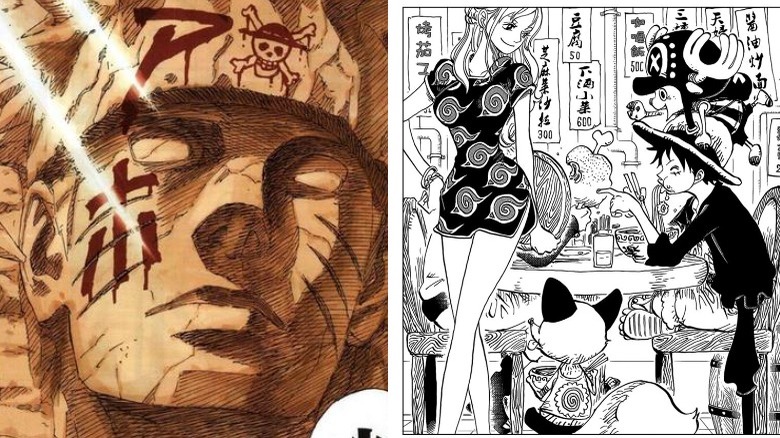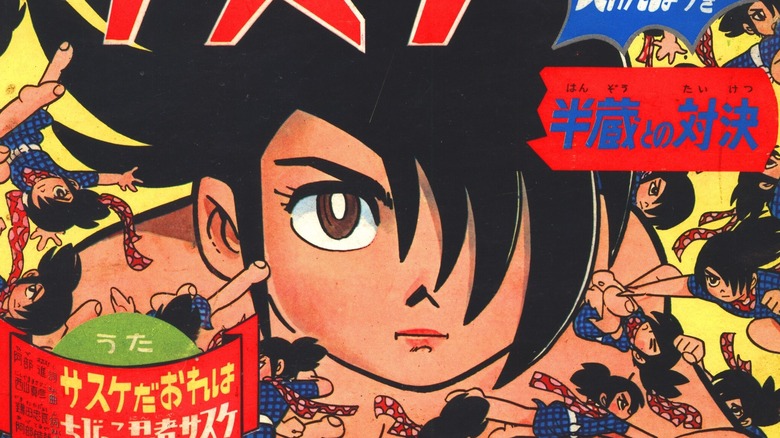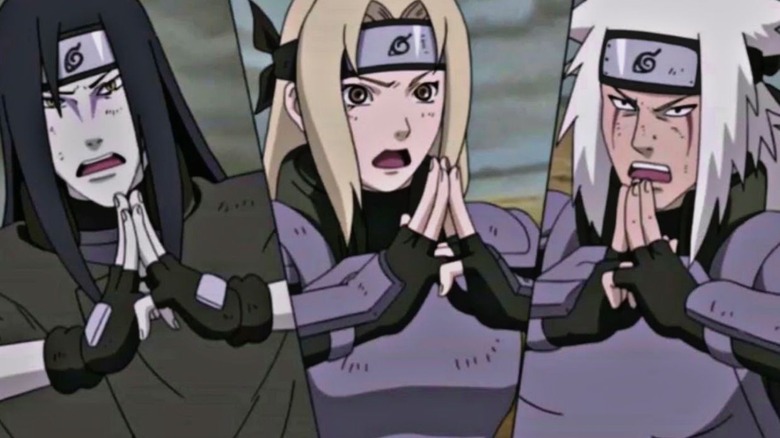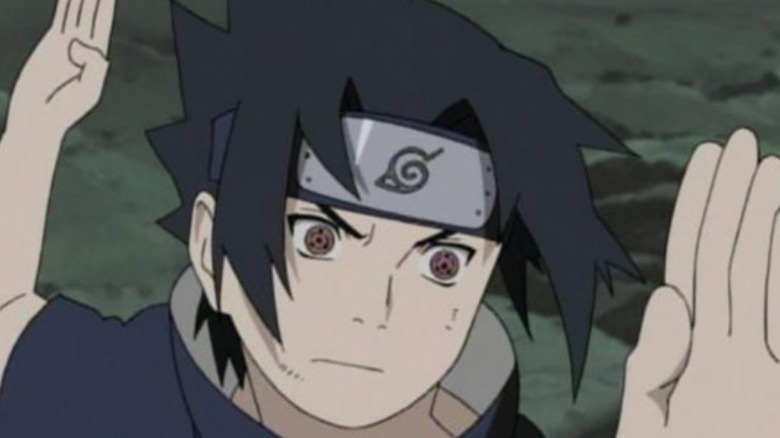Easter Eggs You Probably Didn't Spot In Naruto
It's hard to believe that the "Naruto" anime series is 20 years old. It seems like it was only yesterday when "Naruto" was making its anticipated debut in North America on Cartoon Network. Times have changed significantly since then. Instead of waiting for reruns on Toonami, "Naruto" fans can stream their favorite episodes on sites like Hulu and Crunchyroll. Naruto Uzumaki is no longer a kid dreaming of becoming Hokage of his village — he is the Hokage of his village! And, instead of living a life of isolation, Naruto has a family of his own: His wife, Hinata, a daughter named Himawari, and, of course, his son, Boruto. Fans who grew up with "Naruto" and "Naruto: Shippuden" are once again glued to their screens watching Boruto try to surpass his famous father in "Boruto: Naruto Next Generations."
The 20th anniversary of the "Naruto" series isn't just an excuse to feel nostalgic. It's also the perfect opportunity to re-experience the anime, as there are a lot of surprising Easter eggs hidden deep within. Some of those Easter eggs honor the legacy of "Naruto," while some give a respectful nod to other shows. So, without further ado, here are some amazing Easter eggs you may have missed in the "Naruto" anime — and a few from the manga, to boot.
Chiaotzu makes a surprise appearance
In Chapter 150 of the original "Naruto" manga, "The Training Begins...?!," Naruto and his mentor Jiraiya stop by a funfair to investigate the whereabouts of Lady Tsunade. As they're investigating, Naruto has some fun at the fair with the limited budget Jiraiya has set for him (unaware that Jiraiya intends to indulge himself in booze and women with money he took from Naruto).
In one panel, a booth featuring masks of various characters is shown. One of those masks features the image of Chiaotzu from the "Dragon Ball" series. Considering how much of a fan "Naruto" creator Masashi Kishimoto is of the "Dragon Ball" series and its creator Akira Toriyama, the out-of-nowhere inclusion of everyone's favorite Jiang Shi character isn't as random as one would think. The mask booth also includes other comical faces, including one that seems to be inspired by the "Kamen Rider" series.
This Shadow Clone jutsu scene from Naruto: Shippuden is a deep callback
There are over 200 episodes in the original "Naruto" anime series, and yet, the first one will always hold a special place in the hearts of fans everywhere. The most iconic moment from Episode 1, "Enter: Naruto Uzumaki!," is easily the climax: Naruto puts his training of the Shadow Clone jutsu to good use by overwhelming and overpowering Mizuki after it's revealed that the former ninja instructor tricked Naruto into stealing the forbidden scroll and nearly killed his sensei, Iruka Umino.
The sequel series "Naruto: Shippuden" pays tribute to the memorable Shadow Clone jutsu scene in its third episode. To obtain the bell from his former teacher Kakashi and pass the second bell test — a throwback to the original bell test Kakashi held for Team 7 when they were younger — Naruto unleashes countless clones of himself. The scene is nearly identical to the climax against Mizuki from the original series.
King Kong and Skull Island
The influence of 1933's "King Kong" by Merian C. Cooper and Ernest B. Schoedsack cannot be overstated. This classic monster movie paved the way for spectacle cinema with its effective use of awe-inspiring stop-motion effects. The titular ape would go on to inspire the likes of Nintendo's "Donkey Kong" and the "Godzilla" franchise. While Kong continues to thrive in American pop culture with recent films like "Kong: Skull Island" and "Godzilla vs. Kong," his reach is also seen in the "Naruto" franchise with the character King.
King is a giant gorilla who lives on Genbu, a huge, living island that is said to be inspired by Skull Island, the home of King Kong. The big ape made his anime debut in Episode 243 of "Naruto: Shippuden," entitled "Land Ahoy! Is this the Island of Paradise?" In the episode, Naruto tracks down Killer B to ask him for help in taming the demonic Nine-Tails inside of him.
Kisame's defeat is similar to the ending of Jaws
Who could forget a horrifying shark-like face like the one belonging to Kisame Hoshigaki? Might Guy, apparently: The eccentric sensei couldn't remember anything about the literal shark member of the Akatsuki when they met again in Episode 13 of "Naruto: Shippuden."
As one would expect, Guy's unintentional disrespect of Kisame didn't sit well with the great white ninja. In their battle, Kisame nearly took Guy out with his Water Release: Great Shark Bullet Technique, which creates a gigantic shark made out of water that's able to absorb the chakra of the opponent's technique to increase its size. However, Guy was able to defeat Kisme with his Daytime Tiger, an attack made out of air pressure. Guy defeating Kisame with his air-pressured attack is unbelievably similar to the ending of Steven Spielberg's 1975 blockbuster "Jaws," where Martin Brody kills the great white shark by shooting the scuba tank filled with compressed air that's in its mouth.
The Four-Tailed Beast is one big tribute to Dragon Ball
"Naruto" creator Masashi Kishimoto has shown his love for "Dragon Ball" in many ways, such as contributing a cover redesign for the franchise's 40th anniversary and gushing over his favorite characters in interviews. However, the strongest example of Kishimoto's love of "Dragon Ball" is the existence of the Four-Tailed Beast.
In many ways, the legendary Four-Tailed Beast is one massive tribute to the "Dragon Ball" series. For starters, the beast is named Son Goku, just like Son Goku (commonly referred to as just "Goku" in America) from "Dragon Ball." The host of the Four-Tailed Beast is named Roshi, who is clearly named after Master Roshi. The design of the Four-Tailed Beast also appears to be heavily inspired by the Great Ape transformation of the Saiyans. Last but not least, the number of tails the Four-Tailed Beast has is an apparent reference to Goku's four-star Dragon Ball.
The creators of Naruto and One Piece have referenced each other
Similar to the friendly rivalry between Naruto Uzumaki and Sasuke Uchiha, Masashi Kishimoto and Eiichiro Oda, the creator of "One Piece," have inspired each other during their time at "Weekly Shonen Jump." At New York Comic Con in 2015, Kishimoto talked about how "gratifying" it was when Oda acknowledged him as his rival at the back of Volume 72 of "One Piece." Given the great amount of respect Kishimoto and Oda have for each other, it's no surprise to see them acknowledge each other through their respective titles.
The "Naruto" manga came to an end in 2014. In the final chapter, Naruto's son Boruto draws the jolly roger of the Straw Hat Pirates on Naruto's face on the Hokage Rock. In return, Oda referenced "Naruto" on the cover of Chapter 766 of "One Piece." Nami wears a dress decorated with the symbol of the Village Hidden in the Leaves, while Monkey D. Luffy enjoys a bowl of ramen, Naruto's favorite meal. There's also a little fox wearing a shirt that has the image of a narutomaki on its back.
Kakuzu's techniques are inspired by Mobile Suit Gundam
"Dragon Ball" isn't the only series that "Naruto" creator Masashi Kishimoto is obsessed with. According to Chapter 60 of the "Naruto" manga, Kishimoto is a big fan of the "Mobile Suit Gundam" franchise. In his formative years as a mangaka, he would often draw the mechas from the show like the Zaku, the MS-07B Gouf, the MS-09B Dom, and more. And, just like how Kishimoto couldn't hide his love of "Dragon Ball" in "Naruto," the same is true for "Mobile Suit Gundam."
The attacks of Akatsuki member Kakuzu are all based on famous mechas from the "Gundam" anime series. For example, Kakuzu's Earth Release: Earth Spear jutsu is named after the MS-09B Dom mecha. Another example is Kakuzu's Earth Grudge Fear technique, which is named after the Mobile Suit MSN-02 Zeong. The Fire Release: Intelligent Hard Work jutsu comes from the Gundam MSM-07 Z'Gok.
Sasuke's backstory was inspired by a '60s manga
Sasuke Uchiha, arguably the most popular ninja student in the Village Hidden in the Leaves, has an undeniably tragic backstory: His older brother, Itachi Uchiha, murdered their entire clan. Sasuke and Itachi would eventually come face to face in one of the most memorable moments in the history of "Naruto." His shocking origins and much of Sasuke's character traits were inspired by a 1961 manga by Sanpei Shirato called "Sasuke."
If the title didn't give it away, "Sasuke" follows a boy named Sasuke. He is the son of a renowned ninja named Ozaru. After their lord is defeated, enemy clans start to hunt for anyone left alive in the aftermath. Sasuke and his father are left on their own to survive against rival feudal lords, experiencing pain, anger, and heartbreak as they try to evade their pursuers and stay alive. The "Sasuke" manga received a 29-episode anime series, which premiered in the fall of 1968.
The Sannin are named after characters from Japanese folklore
The "Naruto" series took inspiration for its world and characters from a variety of stories, including a Japanese folktale from the 1800s. The Legendary Sannin — Orochimaru, Jiraiya, and Tsunade — are based on characters from "Jiraiya Goketsu Monogatari," translated as "Tale of the Gallant Jiraiya." Just by glancing at the name of the story, it's unmistakable that Naruto Uzumaki's sensei, Jiraiya, is named after the folktale hero. The story features a slug magic user named Tsunade, who served as the love interest for Jiraiya, as well as an evil snake magic user named Orochimaru.
As you can see, the "Naruto" series not only took the names of these famous literature characters but also kept their respective animal affinities. There's even more to unfold with Orochimaru, as the character is also based on the Japanese mythology of Yamata-no-Orochi (Eight-forked Giant Snake), which inspired the epic battle between Orochimaru and Itachi in Episode 138 of "Naruto: Shippuden."
The Sannin were teased before their debut
Before Lady Tsunade made her grand entrance in "Naruto," her presence and relationship with Jiraiya and Orochimaru were teased earlier in the series. In Episode 83 of "Naruto," entitled "Jiraiya: Naruto's Potential Disaster!," Sasuke Uchiha is seen running through an outpost town searching for Naruto Uzumaki before his brother, Itachi Uchiha, can find him. One of these scenes has Sasuke run past a candy salesman who's wearing three peculiar candies on his head: One is shaped as a slug, another a frog, and lastly, a snake. Ring a bell?
These three candies are shaped as the animals associated with the Legendary Sannin — Tsunade (slug), Jiraiya (toad), and, of course, Orochimaru (snake). Lady Tsunade wouldn't make her official appearance until a few episodes later. Also worth noting is that some of the other candies the man is selling are shaped as pop culture characters, such as Slowbro from "Pokémon" and Mickey Mouse. There's even a candy that's shaped as the Uzumaki clan's crest.
A grand view
In celebration of the "Naruto" series' 20th anniversary, "Boruto: Naruto Next Generations" sent the titular offspring of Naruto Uzumaki back in time, to the Village Hidden in the Leaves of the original series. Boruto wasn't alone, however, as he was accompanied by the adult version of Sasuke Uchiha. The Time Slip arc not only brought back the childhood versions of the original cast, but it also offered plenty of fan service for those who have been following the series since Naruto performed his first Shadow Clone jutsu.
One unforgettable callback is the scene of Sasuke and Boruto having a grand view of the village, which is reminiscent of two particular scenes from "Naruto: Shippuden." One is where Naruto returns to the Village Hidden in the Leaves after training with Jiraiya for three years, and another is where Sasuke returns to the village after abandoning his friends and family for Orochimaru. All three scenes are staged similarly but resonate in completely different emotional ways.
The Naruto Run exit sign
If there's one lasting legacy of the "Naruto" anime series, it's that it taught a generation of kids to run in the most aerodynamic way possible. The "Naruto Run" is the hilarious meme of people trying to imitate the running form of Naruto Uzumaki, either seriously or as a joke. You either saw a kid at school do the Naruto Run, or you were that kid yourself.
With the staff of "Boruto: Naruto Next Generations" made up of fans who grew up watching the original "Naruto" series, classic memes like the Naruto Run are being acknowledged on the show. In Episode 70 of "Boruto," entitled "The Other Side of Anxiety," an exit sign of a man doing a Naruto Run can be seen behind Might Guy as he observes the tournament he set up for Metal Lee. The exit sign just shows that the staff of "Boruto" are in on the joke along with the fans.
Boruto's openings pay homage to the previous series
While "Boruto: Naruto Next Generations" follows a new generation of heroes, the series has never forgotten its roots. Through its various openings, "Boruto" has referenced the iconic openings of "Naruto" and "Naruto: Shippuden." The seventh opening for "Boruto" takes inspiration from several shots from the seventh opening of "Naruto." The shots of Boruto Uzumaki and Sarada Uchiha posing just like their parents are the most unmistakable nods.
The same goes for the eighth opening of "Boruto," which is visually identical to the sixth anime opening for "Naruto: Shippuden." The visuals of Boruto and his friends are staged similarly to Naruto and his crew. Elsewhere, members of the secret society known as the Kara are drawn in a very similar way to the Akatsuki. As "Boruto" continues, there are bound to be even more callbacks to the original series in the openings.
Tobi's face reveal is exactly like Haku's
Among the many takeaways one could have after finishing the "Naruto" series is the fact that Naruto Uzumaki hates masks. Or, at the very least, he can't stand the sight of masked villains. The future Hokage of the Village Hidden in the Leaves knocked the masks off two distinct foes in the series, and in remarkably similar ways.
The first time happened in the original "Naruto" series, during the Land of Waves arc. Naruto delivers a powerful blow to Haku that destroys his mask, revealing the innocent face of the assassin that befriended Naruto earlier in the story. Moving on to "Naruto: Shippuden," the climax of the Fourth Ninja War has Naruto punching the mask from Tobi's face, revealing his shocking identity: Obito Uchiha. Not only are both scenarios similar to each other, but the paneling of each scene in the manga is identical as well.
Bruce Lee and Conan Lee both inspired fight scenes
Whether you're a fan of martial arts or just a movie buff, "Naruto" has you covered. Through its many fight choreographies, the "Naruto" anime series has paid tribute to several famous big screen martial artists. In Episode 133, "A Plea from a Friend," Sasuke is attempting to bypass Naruto and leave the Village Hidden in the Leaves for Orochimaru. The animated sequence in question has Sasuke perform a move that comes from Conan Lee, a Hong Kong-born American film actor and martial artist.
Conan Lee has plied his trade on numerous well-known action films, including "Big Trouble in Little China," "Lethal Weapon 4," "Fantastic Four: Rise Of The Silver Surfer," and "Pacific Rim." He isn't the only Hong Kong martial artist that "Naruto" has honored. The name and mannerisms of Rock Lee are inspired by the legendary martial artist Bruce Lee. Rock Lee shares the same birthday as Bruce Lee (November 27), and even has the same hairdo and style of dress.















